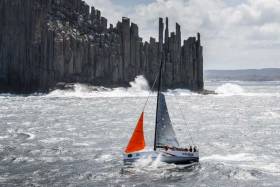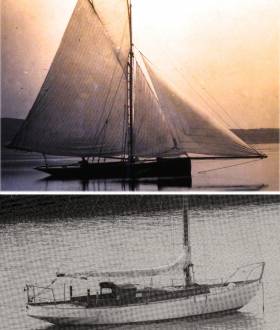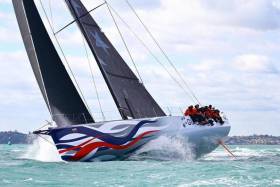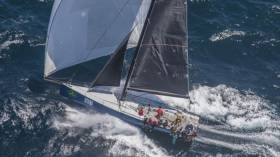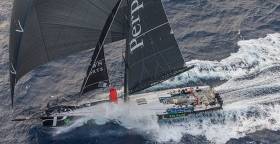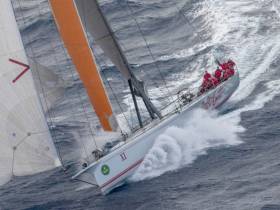Displaying items by tag: Sydney Hobart
107 Yachts for Sydney Hobart Race
The 73rd Rolex Sydney Hobart promises much, with 107 yachts currently scheduled to cross the start line in Sydney Harbour at 13.00 (AEDT) on 26 December. Some 30 international entrants will participate, with a high-profile battle for line honours and fierce contest for the overall win expected. The 628-nautical mile race has never yet failed to deliver intense drama and great spectacle - the 2017 edition looks set to be no exception. First held in 1945, the Sydney Hobart is organised by the Cruising Yacht Club of Australia with the cooperation of the Royal Yacht Club of Tasmania. Rolex has been title sponsor since 2002. An unquestionably iconic sporting challenge, the race sits alongside the other offshore classics, such as the Rolex Fastnet Race and Rolex Middle Sea Race, that underpin the Swiss watchmaker’s association with the sport.
First held in 1945, the Rolex Sydney Hobart is organized by the Cruising Yacht Club of Australia with the cooperation of the Royal Yacht Club of Tasmania. Rolex has been title sponsor since 2002. An unquestionably iconic sporting challenge, the race sits alongside the other offshore classics, such as the Rolex Fastnet Race and Rolex Middle Sea Race, that underpin the Swiss watchmaker’s association with the sport.
LEADING LIGHTS
Last year, a four-way competition to finish first in Hobart resulted in a record-breaking performance by Perpetual LOYAL. Anthony Bell’s 100-foot Maxi rewarded her crew’s persistence and resolve, as man and machine combined to take nearly five hours off the previous fastest time.
Once again, four 100-foot powerhouses are in the running. Wild Oats XI will be seeking to re-establish her benchmark status by adding to her eight line honours successes and taking back the record, weather permitting. Against her, the American Maxi Comanche, first to finish in 2015, is competing under the stewardship of New Zealander Neville Crichton, a two-time line honours winner himself.
Peter Harburg’s Black Jack is the former Alfa Romeo – the fastest yacht in 2009 with Crichton. The Reichel/Pugh design has spent the past five years dominating the northern hemisphere big boat scene. Completing the quartet is Christian Beck’s InfoTrack (previously Perpetual LOYAL).
Racing these highly-tuned Maxis at full tilt over some of the most difficult seas in the world is a true test for both crew and yacht. Any weakness in organization, skill or determination will be ruthlessly exploited by the opposition and the conditions. Preparation is critical and one month out from the start, the race has already begun in earnest for the owners and crews of these pure thoroughbreds.
PEER PRIDE
Away from the rarefied atmosphere of the 100-footers, the majority of entrants are competing for a variety of reasons. Some are relatively simple: a passion for the sport, the camaraderie of teamwork or the opportunity to pit oneself against the challenge. There are prizes throughout the fleet, with classes separated into different bands under handicap. At the finish in Hobart, Tasmania though, one boat will stand head and shoulders above the rest. The crew that wins overall will receive the deserved recognition of their peers and take a place in event legend. Beyond these less tangible rewards, there are the coveted Tattersall’s Cup, with its many years of history, and the Rolex Oyster Perpetual timepiece, engraved with the race name, the year and the words “Overall Winner”.
Over the past fifteen years, the title and rewards have been shared across the fleet, with yachts in the 40 to 50-foot range winning five times and yachts between 50 and 60 feet also winning five times. There have been three wins from the 60 to 70 feet yachts and two wins from the 100 footers. The prevailing weather will be significant in determining the outcome of the race. Inevitably, the conditions favour different lengths of yacht at different times; the strength of the wind and the state of the sea play critical roles. Crews must manage their resources astutely and sail to their yacht’s full potential throughout the period at sea. Complacency and inattentiveness can be ruinous.
FORM BOOK
The 2016 overall winner is back, although in new hands and renamed Wizard. David and Peter Askew from the United States will have their work cut out to repeat the achievement of Jim Delegat and the crew of Giacomo. The last boat to secure back-to-back wins was Freya in 1965. Bob Steel, from New South Wales and owner of Quest, will be hoping the conditions suit the 50-footers. A winner in 2002 and 2008, his current boat also triumphed under the name Balance in 2015. Steel, too, is up against it. This segment of the fleet is full of pedigree. Italian yacht, Mascalzone Latino owned by Vincenzo Onorato, enters after back-to-back wins in her last two 600-mile outings: the 2017 Hong Kong to Vietnam Race and the 2016 Rolex Middle Sea Race.
Chris Opielok from Germany, owner of the TP52 Rockall, may be relatively unknown at this race but he is a proven offshore challenger winning the Admiral’s Cup twice. American Joseph Mele will continue his pursuit of bluewater racing’s greatest prizes. Fresh from participation at this year’s Rolex Fastnet and Rolex Middle Sea Race, Mele and his Triple Lindy team are entering their second successive Rolex Sydney Hobart.
A NOD TO HISTORY
The 52-foot Dorade will debut at the Rolex Sydney Hobart, some 80-plus years after making a name for herself winning some of the world’s classic races. Current owners, Matt Brooks and Pam Rorke Levy, have undertaken an ambitious itinerary in recent years, believing Dorade was born to race in open water and should continue to do so despite her advancing age. The same philosophy could equally apply to Sean Langman, whose Maluka is another octogenarian yacht to take the course; although, in Langman’s case, this has become something of a tradition. Kialoa II will also raise a cheer; a line honours winner at the Rolex Sydney Hobart in 1971, she is on a journey to revisit the scenes of past glories in the hands of Patrick and Keith Broughton. Though the prospects for repeating former triumphs are slim, all three crews will surely win hearts and minds of spectators and crew for their spirit and endeavour.
New Boats for Ireland For The New Year? There Are Other Ways to Change...
The traditional timing of the London International Boat Show as soon as possible after New Year’s Day may have been shifted about in recent years as the changing dynamics of the European marine industry and the sheer dominance through size of Dusselboot (this year’s is 21st to 29th January) have changed the map of international boat selling. Nevertheless the idea that the very beginning of the New Year is an ideal time to interest people in a new boat still holds good, as they’ll invariably be convinced they’ve thought only of gifts for others over Christmas, while their entire lives have been taken over by family festivities. So when New Year arrives, a personal treat with a change in boats is well earned. But is it necessary to get a completely new boat? W M Nixon points to a different solution.
The most significant fact to emerge from the final results of this week’s Rolex Sydney-Hobart Race is that no new boat figured in the top five places overall. All were boats of varying vintage, some quite old relatively speaking. And all had been - at the very least - tinkered around with more than somewhat, even if none had been modified so frequently and completely as the Oatley family’s hundred footer Wild Oats XI.
Admittedly Wild Oats didn’t even finish, but she was leading on the water well past the halfway stage when she had to pull out with a failed keel ram. It could well be that this was one of the few original items in the boat, for Oats has been radically changed so often - with new longer bows fitted at frequent intervals with the stern shortened still further to keep her under a hundred feet – that she now looks for all the world like a one-masted schooner.
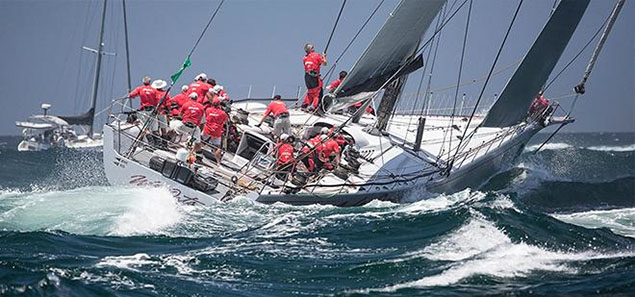 Wild Oats XI has had so much added to her length forward and so much chopped off her stern that she now looks like a one-masted schooner
Wild Oats XI has had so much added to her length forward and so much chopped off her stern that she now looks like a one-masted schooner
Yet at no stage have any of her skillfully-executed hull mods failed. Down in Australia, and in New Zealand too, they’re past masters at doing incredible things with epoxy which, once the job has been finished, look as if they’ve been there from the start. And the fact is that when we look back on the history of sailing development, when timber construction was dominant, the more individualistic shipwrights were game to take on all sorts of challenges for they knew – or at least most of them new – just what could be done with wood while retaining the overall sea-going integrity of the much-changed vessel.
It was only when fibreglass took over as the dominant boat construction material in the 1960s that we went through a period of nervousness of configurational change, when what you got in a plastic boat stayed as what you got in that plastic boat. For a while, people were scared stiff of making any changes to what had emerged from the mould and subsequently from the finishing shop.
But if your boat happened to be of wood, or better still of aluminium or steel, you could emulate the modifiers of old and introduce changes which managed to be locally strong, and also strong within the overall structure of the boat.
Once upon a time, back in 1974, we found ourselves berthed in Crosshaven outside Eric Tabarly’s 64ft ketch Pen Duick VI after an RORC race from Cowes, which he had won both on the water and on IOR. Despite this, the great man was dissatisfied with the location of the sheet leads for the Yankee jib (he had an Illingworth-style cutter rig). So he and his lads got hold of a generator, and there before our very eyes they set up an aluminum welding workshop, cut off the eye, and re-located the sheet leads to the skipper’s satisfaction.
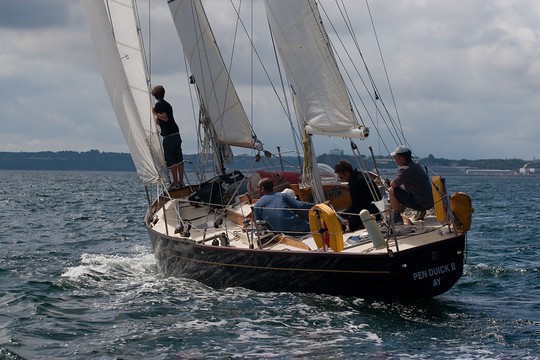 Only the coachroof coaming was timber - Eric Tabarly’s alloy ketch Pen Duick III was easily modified if you’d the aluminium welding kit.
Only the coachroof coaming was timber - Eric Tabarly’s alloy ketch Pen Duick III was easily modified if you’d the aluminium welding kit.
For sure there was singed paint in every direction, but the job was done, and Pen Duick won the next RORC race to somewhere in Brittany even more convincingly, while we sailed home to Howth reflecting that maybe there was more to aluminium than a rather soul-less material best used for building aircraft.
But of course we didn’t need to look very far to see boats that had been modified, sometimes beyond all recognition, in order to maintain appeal to a new generation of sailors. While the Howth 17s of 1898 may have stuck stubbornly to their original design – which they still do – the Dublin Bay 21s of 1902 had since 1963 been changed to Bermudan rig with a new coachroof.
 Dublin Bay 21 in original form – they kept their crews busy, and offered scant comfort or shelter. Photo: Rex Roberts
Dublin Bay 21 in original form – they kept their crews busy, and offered scant comfort or shelter. Photo: Rex Roberts
 The Dublin Bay 21s as they were from 1963 until 1986 - more easily handled, and the luxury of a doghouse,
The Dublin Bay 21s as they were from 1963 until 1986 - more easily handled, and the luxury of a doghouse,
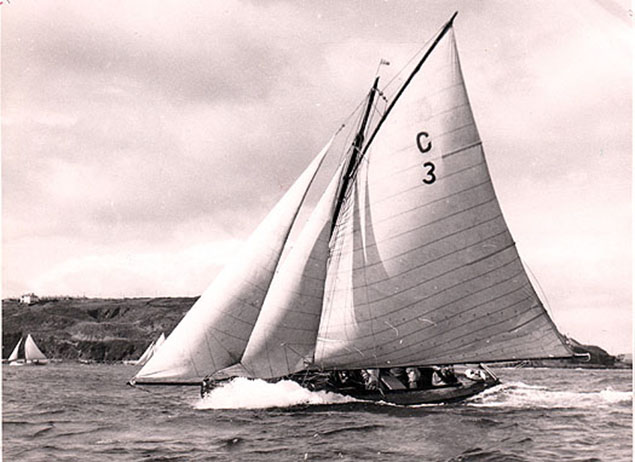 Cork Harbour One Design with classic rig, and open cockpit. Photo: Tom Barker
Cork Harbour One Design with classic rig, and open cockpit. Photo: Tom Barker
 Cork Harbour One Design in bermudan-rigged cruising mode, complete with coachroof and doghouse. Photo: W M Nixon
Cork Harbour One Design in bermudan-rigged cruising mode, complete with coachroof and doghouse. Photo: W M Nixon
And in Cork Harbour, the more senior Cork Harbour One Designs of 1896 vintage had become able little Bermudan-rigged cruisers with an extensive coachroof – complete with doghouse – which allowed them to log some very impressive cruises.
But in both cases, while the boats may have looked completely different above the deck line, their basic hull shape remained the same. Yet if you cared to look in the Coal Harbour in Dun Laoghaire, until the early years of this century a regular resident was the 32ft Bermudan sloop Bonito, which had started life as a plumb-bowed gaff cutter built in Strangford in 1884, yet by the time she reached Dun Laoghaire she was spoon-bowed and sloop rigged under the Bermudan configuration, her owner-skipper being Roy Starkey, whose regular crewmate was Bob Geldof Senr.
In fact, re-configuration seems have been a fact of life for Bonito during much of her existence, as at one stage she was yawl rigged too. But the fascination abut her lay in discerning where the constructional changes had been made to transform her appearance, and it’s a matter of regret that when her life came ignominiously to an end some time after Roy’s death, with the powers-that-be breaking up Bonito and consigning her to a landfill, it was over and done with before anyone was sufficiently aware of what was happening to ensure that her breaking-up a forensic dissection rather than a crude scrapping.
Of particular interest would have been the way in which her straight stem was lengthened into the spoon bow which became fashionable in the 1890s, and has remained fashionable with foredeck crews ever since, as it means you can work at the stemhead without being immersed in every wave, whereas straight stems – or worse still, the reverse stem as seen on CQS in the Hobart race – are a semi-permanent waterfall.
Yacht design undergoes strange mutations which can persist in exaggerated form, and one of the worst was the heavily-canted rudder which began to emerge in the 1840s when the main measurement for handicap and other purposes was along the length of the lower side of keel. The boat builder and designer Thomas Wanhill of Poole in the south of England was soon turning out boats which were significantly larger than their keel length – and hence their rating measurement – suggested, simply by increasing the angle of the rudder.
 John Mulholland’s 1865-built Egeria
John Mulholland’s 1865-built Egeria
So even though the sweetly-steering schooner America with her vertical rudder came across the Atlantic in 1851 and swept all before her, in England the trend towards angled rudders persisted, and in 1865 Wanhill built his most successful schooner, “the wonderful Egeria”, a 99-footer for linen magnate John Mulholland of Belfast, and she performed like a dream despite her markedly angled rudder.
Having the angle enabled the rudder head and the tiller to be well aft to keep the deck amidships clear for crew work, but somehow the idea persisted and indeed became exaggerated until the 1960s, with the Sparkman & Stephens-designed Clarion of Wight, overall winner of the 1963 Fastnet Race, having a rudder which today looks absurd. Admittedly she was a dream to windward, but offwind and particularly with spinnaker set, she was a nightmare on the helm.
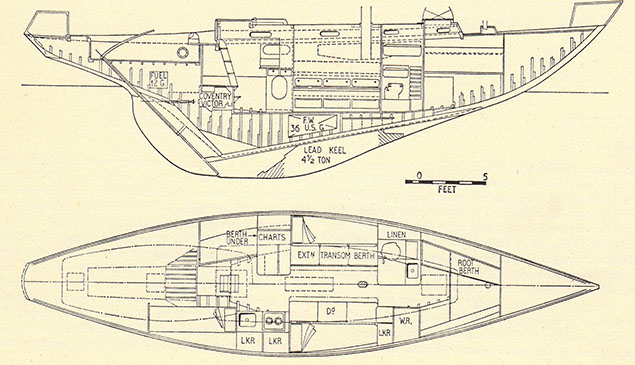 She may have won the 1963 Fastnet Race, but in her original form Clarion of Wight had carried the angled rudder to absurd levels.
She may have won the 1963 Fastnet Race, but in her original form Clarion of Wight had carried the angled rudder to absurd levels.
 Clarion’s successor Firebrand in 1965 showed some modifications to the old rudder shape, but Dick Carter’s new find-and-skeg configured Rabbit won that year’s Fastnet.This particular line of development was knocked in the head when Dick Carter won the Fastnet Race overall in 1965 with his own-designed Rabbit, which was fin-and-skeg with a virtually vertical rudder, and was well-behaved on all angles of sailing. But at the time most sailors persisted in what they thought were improved versions of the old form, and in ’65 Dennis Miller, one of the part-owners of Clarion in ’63, appeared with the new similarly-sized Firebrand with a less steeply-angled rudder which had a pointed tail to give extra power at maximum depth, and that did improve things slightly. But nevertheless Firebrand continued to be the most beautiful-looking boat with the drawback of challenging helming under spinnaker, though as we’ll see, that was to be sorted in due course.
Clarion’s successor Firebrand in 1965 showed some modifications to the old rudder shape, but Dick Carter’s new find-and-skeg configured Rabbit won that year’s Fastnet.This particular line of development was knocked in the head when Dick Carter won the Fastnet Race overall in 1965 with his own-designed Rabbit, which was fin-and-skeg with a virtually vertical rudder, and was well-behaved on all angles of sailing. But at the time most sailors persisted in what they thought were improved versions of the old form, and in ’65 Dennis Miller, one of the part-owners of Clarion in ’63, appeared with the new similarly-sized Firebrand with a less steeply-angled rudder which had a pointed tail to give extra power at maximum depth, and that did improve things slightly. But nevertheless Firebrand continued to be the most beautiful-looking boat with the drawback of challenging helming under spinnaker, though as we’ll see, that was to be sorted in due course.
Meanwhile Clarion of Wight continued to be a handful, so before the 1960s were out, builder Clare Lallow of Cowes was asked to perform the then-major operation of transforming her after-body underwater to give her a fin-and-skeg configuration master-minded by Sparkman & Stephens, who were now advocating this shape with all the zeal of the convert, and in fact had used early versions of it in boats like Deb, later Dai Mouse III, now Sunstone, which had been built in 1965.
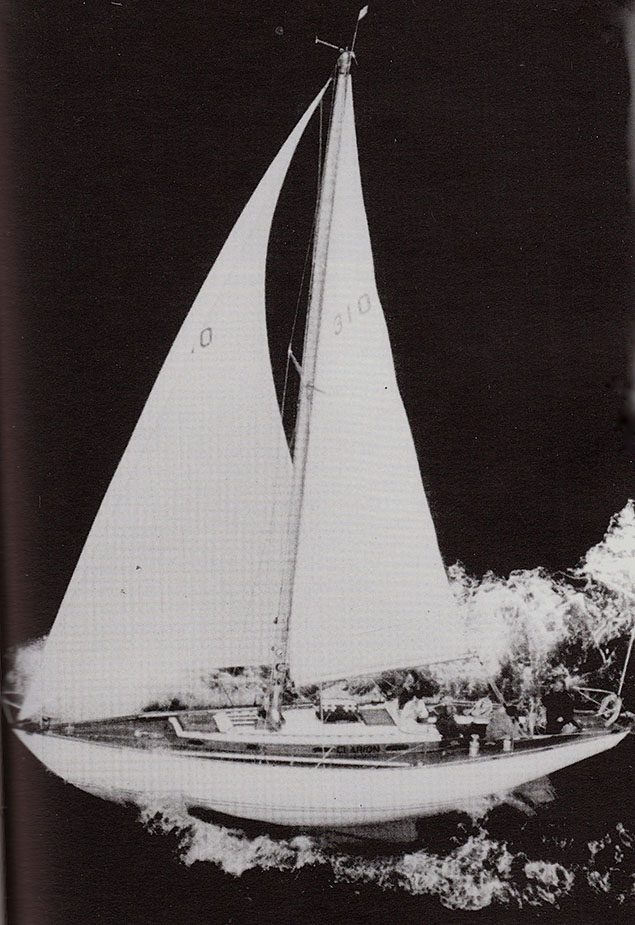 Clarion of Wight in the 1971 Fastnet Race in Rory O’Hanlon’s ownership, when she won the Philip Whitehead Cup. Her new vertical rudder arrangement is discernible.
Clarion of Wight in the 1971 Fastnet Race in Rory O’Hanlon’s ownership, when she won the Philip Whitehead Cup. Her new vertical rudder arrangement is discernible.
Thus to some extent it was the conservatism of owners which persisted in keeping the old style, and of course the vertical separate rudder had long since been advocated by designers like Ricus van de Stadt and Uffa Fox. However, getting the change to into favour with the mainstream in sailing was a different proposition altogether, and you’ll still meet those who prefer keels as long as possible with “gracefully angled” rudders, and good luck to them.
But increasingly the tendency was to the new form, and for those who cannot see any boat without wishing to modify her in some way, it was a magic time, particularly in places like Australia and New Zealand where there seems to be a skilled craftsman round every corner, and regular major boat modifications are almost a way of life.
As for the mainstream, the process was more gentle, but when the most accomplished offshore racers of their generation, the Americans Dick Nye and his son Richard, went to designer Jim McCurdy for a new race boat in 1968, the 47ft alloy-built Carina was given a conservative fin and skeg configuration complete with trim tab on the aft end of the fin keel.
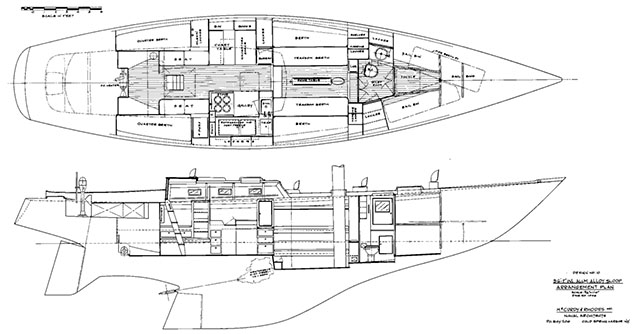 Jim McCurdy’s plans for Carina in 1968 showed a conservative interpretation of the fin-and-skeg form, and relied on a trim tab on the aft end of the fin keel to give added lift to windward.
Jim McCurdy’s plans for Carina in 1968 showed a conservative interpretation of the fin-and-skeg form, and relied on a trim tab on the aft end of the fin keel to give added lift to windward.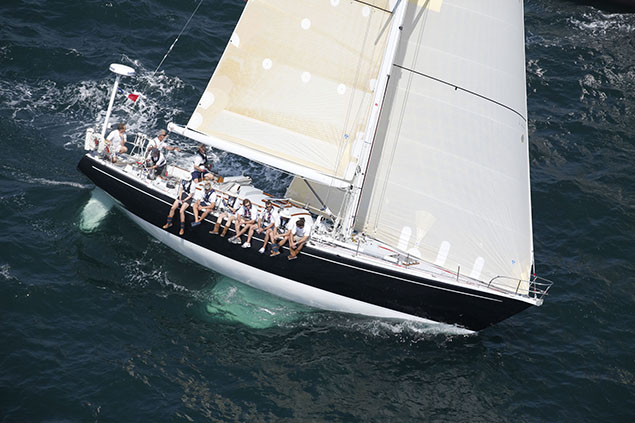 Carina as she is today, and still winning races. She has a spade rudder and Peterson/Holland fin keel arrangement designed by Scott Kaufmann.
Carina as she is today, and still winning races. She has a spade rudder and Peterson/Holland fin keel arrangement designed by Scott Kaufmann.
But that trim tab was punished by changes to the rating rules in the early 1970s. So by 1978 they’d gone to New Zealand-born, New York-based Scott Kaufmann, and he came up with a real dream of a re-configuration with a very positive spade rudder with perfect end-plate effect on the underside of the counter, and a fin keel of the type favoured by Doug Peterson and Ron Holland.
Thanks to Carina’s alloy construction, it was a very manageable job, even if those actually doing it in Bob Derecktor’s famous boatyard found the initial aluminium grinding and cutting to be dusty hard labour. One of that work team was Rives Potts, who has now owned Carina himself for many years, and she continues to win races.
As for her seaworthiness under her new keel and rudder, that was immediately proven beyond all doubt with her successful participation in the 1979 Fastnet. But not all rudder conversions have been so successful. The lovely Firebrand ended up in America, and some owner decided she needed a fin and skeg rudder arrangement. The job was done, but then when she was sold back to Europe, the new skeg broke clean off while sailing Transatlantic. But thankfully it was an add-on rather than an insert into the basic construction, so she got across in one piece.
And then her luck turned. She was spotted by international yacht designer Ed Dubois, who fell in love with her, and decided to make Firebrand his pet boat. Her personally designed a special spade rudder which would retain the classic character of the yacht while improving the steering, and under this arrangement, between intervals of designing superyachts for other people, he had many cherished times sailing and cruising this most beautiful vanished boat before his untimely death at the age of 63 earlier this year.
It’s a great compliment to the beauty of the hull designs of Olin Stephens that a designer of Ed Dubois’s standing should not only choose one of his boats, but at the Dubois home it was a fine photo of Firebrand under sail which had pride of place above the living room fire.
So boats can go through good times as well as bad, and one much worked-on boat which is currently sitting pretty is Anthony Bell’s hundred foot Perpetual LOYAL, line honours winner in the Rolex Sydney-Hobart race, and second overall on corrected time. In that kind of company, it is an achievement comparable with Rambler 88’s performance in the Volvo Round Ireland Race back in June. Yet in all the excitement, how many now remember that back in August 2011, Perpetual LOYAL was Rambler 100, and she was very upside-down with a broken keel out at the Fastnet Rock?
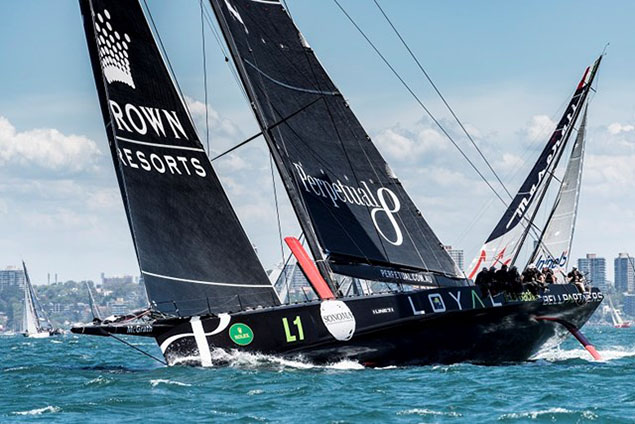 Perpetual LOYAL leads the fleet out of Sydney Harbour five days ago in the Rolex Sydney Hobart Race 2016. Photo Rolex
Perpetual LOYAL leads the fleet out of Sydney Harbour five days ago in the Rolex Sydney Hobart Race 2016. Photo Rolex
 Once upon a time, near the Fastnet Rock..…..Perpetual LOYAL as she was as Rambler 100 in August 2011
Once upon a time, near the Fastnet Rock..…..Perpetual LOYAL as she was as Rambler 100 in August 2011
Irish Navigator Adrienne Cahalan who is, one of Australia's most celebrated yachtswoman, arrived in Hobart aboard the Brenton Fischer skippered TP52 Ragamuffin this week, to cement her place as the first woman ever to compete in 25 Sydney Hobart Yacht Races.
And like all the others, this 25th race has been a mixed bag. No real terrors this year, and mercifully brief time working to windward, but if ever there was a race of two halves this has been it.
Blisteringly fast running and reaching most of the first half, and frustratingly slow in the second half for yachts in the 50 to 65 foot range.
"I prayed for an exciting race and this was that," Cahalan says. "We knew there were going to be some tricky bits, particularly at the end. It was fast, wet and wild at first, particularly on these boats."
Unfortunately it was a little too fast for one crucial moment on the first night. Ragamuffin dove into a wave and emerged with a shredded spinnaker.
"After that, we were playing catch-up, but without that sail we were down a couple of knots. We worked hard though, and eventually recovered.
"Actually we were quite happy with the second half of the race, it suited us. We sailed well through the transition zones and caught back some time. Because we had that sail problem, we missed the gate into Bass Strait, and after that there were three distinct fleets.
"It's worked well for me before - and sometimes it hasn't, but I'm philosophical - some of it is out of your control."
Adrienne was part of the Cheyenne crew which broke the Round the World World Speed Record in 2004, she has circumnavigated the globe on several projects, and has had four World Yachtswoman of the Year nominations.
Irish Sailing Hopes in Sydney–Hobart Race Dampened & Dashed
While Ireland basks in unusual January sunshine, in the alleged Southern Hemisphere summer the normally picturesque approaches to Hobart in Tasmania have seen dull, damp and drifting conditions for the groups of legendary Australian and international racing machines struggling to finish the Rolex Sydney Hobart Race 2016 writes W M Nixon
After magnificent sunny sailing conditions for much of the 628 miles down from Sydney had been able to sweep local hero Anthony Bell’s hundred foot Perpetual LOYAL to a new course record, the fair winds kept up only for long enough to bring New Zealander Jim Delegat’s Volvo 70 Giacomo (ex-Groupama) in to conclude a superb performance which put the Kiwi contender firmly into the Best Corrected Time slot.
At that time, the fleet overall leader on corrected time for most of the race had been Matt Allen’s TP52 Ichi Ban, with Ireland’s Gordon Maguire as sailing master. In such a fast moving race, it says everything for the way that Maguire and his crew have got to grips with this smaller boat in a relatively short time. After two years of campaigning the Carkeek 60 of the same name with mixed success, the 52ft Ichi Ban was able to open up prodigious leads of thirty miles and more in the race from Sydney on her closest rival, Paul Clitheroe’s TP52 Balance, overall winner of the Rolex Sydney Hobart Race 2015.
But that was only when the going was good out in open water. With a low pressure area developing to the northwest of Tasmania, just seven minutes after Giacomo had swept across in such style, the rain came in and the wind took off. The already tortuous approaches to the finish line in the heart of Hobart at the head of the Derwent Estuary became the Waterway of Wasted Hopes. Big boats and then not-so-big boats came sweeping along to within forty miles or less of the finish, and then hit a complete blank wall of total calm and mind-numbing drizzle, such that at one stage three maxis were kedged within a mile of the finish.
But none suffered more in overall terms than Ichi Ban. As Sydney-Hobart veterans, they well knew the problems they faced, for although they led on paper, they’d to sail the last sixty miles in six-and-a-half hours if they were to maintain the exalted winning position they’d held for more than a day.
For Hobart Race aficionados and Gordon Maguire-supporters worldwide, it was agonising last night to see it all fade away with the speed down to less than a knot at one stage, yet all the time out to sea, comparable rivals such as Balance and the Chinese Cookson 50 UBOX were making hay in a still brisk breeze.
When you’re first into the calm, there’s always the added pain of knowing that boats you’d seen off a day or two before could come up with a new wind and actually pass you. But at least Ichi Ban managed to avoid this, though only just. She made it across the line still ahead of Balance by 48 minutes, and had 54 minutes in front of UBOX.
Both were within hailing distance. Yet only 24 hours earlier, they’d been very invisible from Ichi Ban, far beyond the northern horizon astern. But to provide the final downer, as both had marginally lower ratings, they moved into corrected times ahead of the Matt Allen/Gordon Maguire team.
In what has become a big boat’s race in the style reminiscent of the Volvo Round Ireland Race back in June, the overall winner is the Volvo 70 Giacomo, but thanks to those Hobart calms, the new record holder Perpetual LOYAL now lies second overall, while UBOX is third, Balance is fourth, and Ichi Ban is fifth.
In theory, some smaller boats still at sea could change this, but they’ll have to sail fast and steady to do so, and the conditions aren’t too favourable for that kind of showing. As to other Irish hopes, the JV62 Chinese Whispers, which has Shane Diviney in her crew, made a better showing than most of the slow finish, and crossed the line 18 minutes ahead of Ichi Ban, which had led her on the water for much of the race. However, Ichi Ban stayed ahead on corrected, as the larger Chinese Whispers was calculated into 9th overall.
Out at sea, Barry Hurley and Kenneth Rumball on the First 40 Breakthrough still have 198 miles to race, and currently are 13th in Division 3, but the way this event has panned out, many things are still possible for them before they get to Hobart.
New Race Record in Sydney Hobart Yacht Race
Arriving in Hobart at 02:31.20 on Wednesday 28 December, Anthony Bell’s 100-ft Maxi Perpetual LOYAL has set a new race record of 1 day, 13 hours, 31 minutes, 20 seconds at the Rolex Sydney Hobart and in the process secured line honours in the 72nd edition of the famous offshore race.
Perpetual LOYAL’s remarkable time is 4 hours, 51 minutes, 52 seconds faster than the previous record set by Wild Oats XI in 2012. It is the 12th time since the inaugural race in 1945 that the record has been broken.
Perpetual LOYAL began the 628-nm race with intent, making an impressive start as the first yacht to pass Sydney Heads. Although she relinquished leadership of the race to the all-conquering Wild Oats XI during the rapid passage down the New South Wales coast of the Tasman Sea, Bell’s crew was first to take advantage of the hydraulic ram failure sustained by the race leader nearly 21 hours into the contest. “We were probably neck and neck with Wild Oats, maybe a mile away, when it happened,” explained Bell. “It was sad to see them break. We would like to have played on against them...but that’s racing.”
Bell and his crew of 18 comprises a number of experienced competitors including 25-time Rolex Sydney Hobart campaigner Brad Kellett and sailors – including Pablo Arrarte and Justin Clougher – who enjoyed line honours success 2015 onboard the American yacht Comanche. This in addition to Tom Slingsby, Olympic gold medallist and Rolex World Sailor of the Year in 2010. “Going into the race, we had nothing to lose,” revealed Bell. “We came out of the blocks and raced one hell of a race. It was never part of our plans to break the race record but it’s an awesome thing to have done.”
“This is a boat which goes in certain conditions and doesn’t go in others,” explained Perpetual LOYAL navigator Tom Addis, part of the Wild Oats XI crew which broke the race record in 2012. “We had to limit the damages on the first afternoon and set ourselves up for the conditions which were going to be in our favour on the second day. We had to play a different game to Scallywag and Wild Oats in where we set up for the reaching stuff. That was the key because while we didn’t lead through that, as we are not a boat that excels in getting downwind, we came out in a good position.”
“Taking nearly five hours off the race record, hopefully it will take a long time to beat,” added Slingsby.
Bell, who won a close-fought contest with Wild Oats XI in 2011 on his previous LOYAL, celebrates a second Rolex Sydney Hobart line honours success, all the more special given Perpetual LOYAL was forced to retire from the last two editions of the race. During the line honours presentation held on Constitution Dock, Bell was presented with the J.H. Illingworth Trophy and a Rolex Yacht-Master II timepiece.
Perpetual LOYAL was not the only yacht to arrive in Hobart inside the previous race record time. Jim Delegat’s Volvo 70 Giacomo finished just under two hours behind the line honours winner. A little over two minutes later arrived Seng Huang Lee’s 100-ft Maxi Scallywag.
With the contest for line honours now sealed, the spotlight focuses more intensely on the race’s most treasured prize – the Tattersall’s Cup and Rolex timepiece awarded to the overall race winner on handicap. As Afloat.ie reported earlier, currently leading that race is Matt Allen’s TP52 Ichi Ban. How fast she and a clutch of 50-ft yachts are able to negotiate the last stretch of the race, including the notoriously tricky passage down the Derwent River, may prove decisive.
Irish Eyes on Howth Yacht Club's Gordon Maguire As He Holds Lead To Hobart
As records tumble in this fastest-ever Rolex Sydney-Hobart Race with Anthony Bell’s line honours-winning hundred footer Perpetual LOYAL taking four hours and fifty-one minutes off the previous best time set by the late Bob Oatley’s Wild Oats XI, Matt Allen’s TP52 Ichi Ban, with Howth Yacht Club’s Gordon Maguire as sailing master, continues to head the fleet on IRC Corrected Time for the coveted Tattersall’s Cup writes W M Nixon.
But although Ichi Ban has been conspicuously out-performing every other boat of comparable size on the water, not to mention showing the way to many larger craft, when Jim Delagat’s Volvo 70 Giocomo (ex-Groupama) crossed the finish line second on the water in Hobart at 17.27hrs Irish time today, she moved into the Best Corrected Time slot and set Ichi Ban the task of sailing the final 68 miles up the increasingly flukey approaches to Hobart in six and a half hours.
As Ichi Ban was sailing at better than 16 knots when Giocomo finished, it’s all manageable. But nevertheless it will need a mountain of chips to fall the right way for Allen and Maguire to carry it off, for it should be borne in mind that Giocomo was gliding along at barely 7 knots when she finished in Hobart’s sheltered water. However, barring accidents, Ichi Ban certainly has the Class 1 win in the bag, as her nearest rival, Paul Clitheroe’s TP52 Balance (overall winner in 2015), is more than thirty miles astern.
In the midst of all this excitement, spare a though for Mark Richards and the crew of the endlessly modified hundred footer Wild Oats XI. They’d very quickly recovered from one of those starts in Sydney Harbour which any crew prefers to forget, and had a good lead on the entire fleet, well on course to knock their own record for six. But then the hydraulic ram on the canting keel failed, and they had to retire.
Records Set to Fall in Sydney Hobart Yacht Race
Records are set to be broken at the Rolex Sydney Hobart Yacht Race. The frontrunners, having negotiated the infamous Bass Strait, are making rapid progress down the east coast of Tasmania on route to the finish in Hobart.
At 15:30 local time and some 26 and a half hours into the race, Anthony Bell’s Perpetual LOYAL led the fleet sailing well within the current race record time of 1 day, 18 hours and 23 minutes. She was 170-nm from the finish and travelling at a consistent 20 knots. The current holder of the Rolex Sydney Hobart race record and perennial line honours favourite Wild Oats XI was forced to retire from the race this morning after sustaining keel damage on the approach to the north-east coast of Flinders Island in eastern Bass Strait.
Bell is now on target to claim a second line honours success having triumphed with a previous version of LOYAL in 2011. Perpetual LOYAL, and her closest pursuers, are on course to arrive significantly within the race record time, possibly by as much as seven hours.
Second on the water and 18-nm behind the leader was Jim Delegat’s New Zealand entry Giacomo, seeking to become the first non 100-ft yacht to claim line honours since 2004. Another 70-ft yacht - Maserati - lay in third place, 10-nm astern. On corrected time, Giacomo is currently leading the fleet in the quest for the race’s most coveted prize, overall victory on handicap. Further twists and turns are expected in the coming hours.
In addition to Wild Oats XI, three yachts – Dare Devil, Freyja and Patrice – have retired from the race. 84 yachts are still sailing.
Howth's Gordon Maguire In Contention for Overall Sydney–Hobart Honours
Day five of the Rolex Sydney Hobart sees the lion’s share of the fleet fast approaching the finish line and a defining battle for IRC 0 between Ichi Ban (AUS) and Chinese Whisper (AUS).
Comanche may have taken taken Sydney-Hobart line honours but as Winkie Nixon tipped, Gordon Maguire of Howth Yacht Club and the Carkeek 60 Ichi Ban remain in contention for overall victory.
Watch the Rolex Sydney Hobart Yacht Race 2015 - Day 5 - Fleet fast approaching Hobart Video above.
America's Comanche Sails to Victory in Hobart
Jim Clark and Kristy Hinze-Clark’s super maxi Comanche pulled off an incredible feat tonight, taking line honours in the 71st edition of the Rolex Sydney Hobart Yacht Race, winning the Illingsworth trophy and a Rolex Yacht Master II timepiece. This was the first time in 17 years that the most coveted title in offshore yacht racing has been won by an American team since Larry Ellison’s Sayonara won in 1998.
Designed to break records, the 100 foot maxi debuted in last year’s edition of the Rolex Sydney Hobart and since then has circled the globe, collecting the most prestigious titles in yachting – setting a new 24 hour monohull distance record, line honours in the New York Yacht Club Transatlantic Race and the Rolex Fastnet Race – Comanche’s performance this past year has been unlike anything ever seen in yacht racing. Returning to Australia, seeking the title that they so narrowly missed out on last year, was a Herculean effort, which has paid off nicely.
Despite facing retirement after having suffered significant damage (to a dagger board and rudder) on the first night, skipper Ken Read made the game-changing call to effect repairs and finish the race, saying: “I don’t care if we limp over the line!”
A true test of stamina and determination, the international crew of 21 included co-owner Kristy Hinze-Clark and fellow Australian, America’s Cup winner Jimmy Spithill. Commenting on her first Rolex Sydney Hobart, Hinze-Clark described her experience: “It was really gruelling. Pure terror at one stage. Excitement and now just total joy. It's one of the best things I've ever done.”
The French-designed maxi managed to extend their lead this afternoon as they rounded Tasman Island and crossed Storm Bay towards the finish line, putting solid distance between fellow American competitor George David’s Rambler 88, which is expected to finish in the early Tuesday morning (AEDT). Syd Fischer’s Ragamuffin 100 is in close pursuit despite having severed their starboard dagger board overnight, crashing through the rough seas.
The 2015 edition of the Rolex Sydney Hobart Yacht Race has delivered some of the most grueling race conditions since 2004. Almost one third of the fleet of 108 retired in the first 48 hours – the litany of damage included rudders, dagger boards, masts and sails. The remaining teams have their sights set on the finish line in Hobart in hopes of a win on corrected time.
Most of the smaller yachts have only just passed the halfway mark in Bass Strait and as the breeze continues to lighten towards the Tasman coast the Tattersall's Cup, for overall corrected time winner, is still in play.
Comanche's official finish time for the 2015 Rolex Sydney Hobart Yacht Race was 2 days, 8 hours, 58 minutes and 30 seconds.
Comanche Extends Lead in Sydney–Hobart Yacht Race
The crippled American supermaxi Comanche has extended her lead over the similarly damaged Rambler in the closing stages of the Sydney–Hobart Yacht Race.
In the middle of the race's wild first night southerly bashathon Ken Read was considering going home? Something had taken off most of Comanche's starboard side dagger-board and rudder. Read told the Race Director at the Cruising Yacht Club in Sydney it was all over.
But then he decided that they had come so far, damned if they wouldn't finish this race. He called Sydney back.
Syd Fischer's Ragamuffin 100 is the latest of the supermaxis to suffer daggerboard problems in the Rolex Sydney Hobart Yacht Race, but in this case, it is the port daggerboard, and it has completely sheared off, forcing the crew to use desperate measures to continue in the 628-nautical mile race.
With the giant American super maxi Comanche looking certain to carry off the line honours trophy in the 2015 Rolex Sydney Hobart, second-placed Rambler may yet live to console herself with the biggest prize of all: the Tattersall's Cup for the outright winner, the one that performs best according to its size.
Throughout the morning the smallest boats, way back on the other side of Bass Strait, have led the Cruising Yacht Club of Australia's race overall, with Rambler the only big boat currently in the top 10.
For the past two hours, Rambler has steadily climbed the handicap ladder and now sits at second place, behind Enchantress, the little home-built cedar Muirhead 11 from South Australia, sailed gamely by John Willoughby.
And the forecast, at this stage, isn't looking good for the littlies either. There is a distinct absence of breeze predicted for Bass Strait tomorrow, precisely when the back-markers need it. -- Jim Gale, RSHYR Media
Top five places at press time, 330 PM local time December 28
1. Comanche, 59 nm to finish
2. Rambler, 83
3. Ragamuffin, 128
4. Maserati, 177
5. Chinese Whisper, 203



























